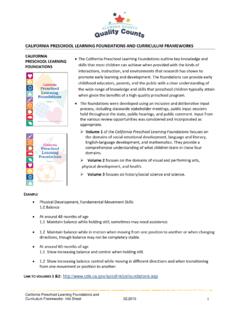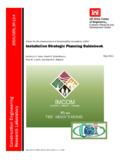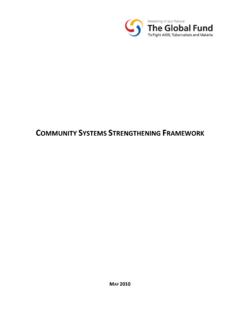Transcription of Executive summary.Key Informant Interviews.July 1
1 1 Executive summary Key Informant Interviews to Inform First 5 Alameda County strategic Planning Prepared by: Wendy Constantine Research & Evaluation Systems july 1, 2012 2 INTRODUCTION On May 10, 2012, First 5 Alameda County (F5AC) selected Research & Evaluation Systems (RES) to conduct 20 interviews with key informants. These key Informant interviews, together with other planning efforts, will ensure that F5AC s goals, strategies, and funding allocations for fiscal years 2013-2017 will be appropriate for meeting the evolving needs of Alameda County s children 0 to 5 years of age and their families. METHODS Approach to Developing the Key Informant interview Schedule: Starting on May 16, the evaluator began a collaboration with F5AC staff on a rapid turnaround schedule to revise the initial and subsequent interview protocol drafts.
2 After a pilot test interview with a key Informant , some of the questions were re-ordered to improve question flow and other questions were revised to improve clarity and reduce interview length. Setting up the Key Informant Interviews: The initial approach for requesting the interviews was made by letters sent by email. The letters were emailed to each potential key Informant explaining why the interview was being requested, asking the person to participate, and saying to expect a phone call to set an appointment for the in-person interview . The letter also explained that a transcript of their interview responses will be shared with F5AC but their names would not be associated with their responses in any publications. Conducting the Interviews: Between May 23 and June 14, a total of 22 (from the initial list of 27) key Informant interviews were conducted, for a response rate of 81%.
3 (See Attachment A for a table showing the initial list of 27 potential key informants by category of employment.) Analyzing Results and Creating a Report: For each question in the interview schedule, a document was created on which a brief description of each key Informant s views was tabulated. As interviews were tabulated, the document reflected the extent of commonality and variation in responses across informants. Tables were created and are provided in the full report to provide information on the number of key informants holding each expressed view. RESULTS The interview schedule included nine questions. The results for each of the nine questions appear below. Question 1 When asked to choose from four First 5 Alameda County outcome areas which one was their agency was most aligned: 9 chose identification and treatment of children with developmental and behavioral issues 9 chose kindergarten readiness 3 chose parenting support 1 chose parent/primary caregiver mental health 3 Question 1a When asked what role F5AC should play in moving toward an early childhood system of care in their chosen outcome area, a total of 43 recommendations were received.
4 Two thirds of these recommendations were that F5AC should assume what could be characterized as an intellectual leadership role. The remaining third of these recommendations were that F5AC should continue to support or expand specific partnerships or services. Below are quotes from the interviews that illustrate the range of intellectual leadership roles that key informants suggested. F5AC is on the vantage point to have objectivity, set the vision, see connections, develop policy recommendations, and advocate. Continue to serve as convener to develop a large systems effort in this area, including social services, early childhood education, and public health. Lead in the use of common goals, tools and data collection. Question 1b When asked to identify existing barriers to moving toward an early childhood system of care, the most frequent responses were: Difficulties in allocating scarce or limited resources, for example, balancing the need to spread resources to a large population vs.
5 Giving the resources in a more focused way to a specific population or geographical area Existing agencies and systems are fragmented, approaches and outcome measures are not unified Knowledge limitations: how to identify families needing services, agencies/services that are available, and how to connect them Other barriers mentioned included: difficulties in determining and prioritizing, , determining best practices, determining where to start, current organizational/administrative structures among agencies as well as their resistance to change, and a lack of community knowledge on the importance of the early years for development. Question 1c Would your agency participate in developing common outcomes and data collection efforts to measure success countywide? 19 key informants said yes.
6 2 key informants said it depends. 4 Including those saying it depends, concerns expressed by eight respondents included: we can share aggregate data only; we can find shared outcomes, however, each agency needed to report their own outcomes to funders; and the need to work for simplicity and ease of data collection. Question 1d What would you or your agency need from F5AC or others to participate in common outcome definition and measurement? Of the 20 comments received, the responses of key informants included: leadership (5), funding (4), we are already working with F5AC (2), we need more information about F5AC (2), nothing (1). Seven responses included the need for a goal of designing a data system that does not overburden agencies, including: the system should not require us to duplicate entry for data we are already collecting and entering to meet other funder obligations; the need to identify measures already being collected that could be good measures for this system ; and the need for an action plan to identify a few outcomes, and the tools to measure them.
7 Question 2 (In addition to a short list of systems initiatives that were shown to the key informants), in what other systems-focused initiatives do you believe First 5 Alameda County should be involved? The many responses obtained are provided in the full report. Question 3 What other key partners should F5AC be working with that are not currently involved in any systems initiatives as far as you know? The many responses obtained are provided in the full report. Question 4 Key informants were asked what two roles F5AC should play in promoting a systems-focused initiative in the county. (Two responses per key Informant ). The roles together with the number of key informants suggesting them are listed below: Leadership in determine common outcomes and data specifications 10 Leadership in resource development, , grant writing 10 Leadership in improving coordination between agencies, serve as convener or referral hub for a systems approach 9 Technical assistance, training, and/or professional education 6 Serve as a resource for conducting or disseminating research 5 Provide advocacy and/or public awareness campaign 3 5 Question 5 Other comments on the role First 5 should play to promote an early childhood system of care in the County included.
8 Serve as a strong advocate/spokesperson for a family and child-centered system of care 5 Continue to do the good work you are doing serve as convener, sit a multiple tables, supporting experts, staying abreast of current research, and planning for the future 4 Continue to work with the school districts 3 Focus on place-based, neighborhood initiatives of communities of greatest need 3 Seek funding opportunities 2 Many other suggestions were made and are listed in the report. The vast majority of key informants are enthusiastic about F5AC taking on this role. For example, one key Informant said: They are doing a great job now, have gotten all of the key stakeholders together, and stay abreast of current trends and research. That kind of research and convening is essential.
9 Question 6 Even while moving more into systems change efforts, what role should F5AC play in ensuring that families are able to care for and promote their children s optimal development? The most frequently made recommendations: Educating parents 9 Providing other parental support 9 Continue to support direct services/include screening/support programs that have demonstrated positive outcomes 5 Adopt and advocate a framework for strengthening families 4 Key informants had many comments regarding this question. A comment on parent education: Awareness, educating families. I think a lot of neglect issues can be avoided if parents or other caregivers know what issues to be aware of and get services for their children. I see child abuse and neglect has a public health components and educating and equipping parents and caregivers early When they leave the hospital, they should have info on how to contact the services of First 5.
10 This is on the top of my list. system transformation from the ground up. Regarding other parental support, a key Informant said: Providing parents with info or help with nutrition, healthy means, ways to cope when tired and the children want attention. Those kind of everyday things that families need to 6 be healthy, preserve the mental health of parents. The families need to know how important those early years and not just park them in front of the TV with a cup of noodles. Provide information to parents on how to get it done in a way that is healthy for your family but does not take all of the time and money in the world. Build on the strengths of the family s resources, identify who can help with the family. If you have a dad who does not get along with the mom, figuring out how that dad can provide assistance to that family.






